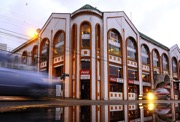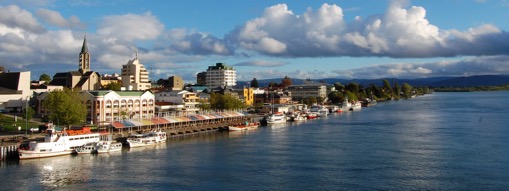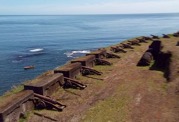
Venue
Universidad Austral de Chile - Valdivia
The first records of the Universidad Austral de Chile was in 1942, when a group of prominent personalities from Valdivia, led by Dr. Eduardo Morales Miranda, gave life to the so-called Friends of Art Society, an entity that promoted the cultivation, development and dissemination of culture in Valdivia for the construction of a University.
This idea was accepted in the 1950s by the senator from the province of Valdivia, Mr. Carlos Acharán Pérez de Arce, who from the stands of the National Congress, announced the project.
Foundation
The Universidad Austral de Chile was founded by Supreme Decree No. 3,757, of September 7, 1954, in Valdivia, in response to the urgent need to have a university in the south of the country.
The inaugural act was held on March 12, 1955, with the President Carlos Ibáñez del Campo and the Rector Dr. Eduardo Morales.
A definitive guide to Chile and the city of Valdivia. The workshop venue, where to stay, what to do, where to eat and drink…
Chile
With its snow-capped mountains, dazzling lakes, the world’s highest and driest desert, breathtaking glaciers and icefields, and a 3,500-mile coastline, this is a land of superlatives and contrasts on a remarkable scale. Its unique natural characteristics aside, Chile is something of an anomaly in Latin America, admired as much for its rock-solid economy, social and political stability, and the superb infrastructure of its capital city, as it is for its fruit and wine.
 |
Since 1989, the country has grown year after year, recovering admirably from almost two decades of dictatorship to become an example of industry, resilience, and creativity. The country has become the business hub for multi-national companies, while at the same time encouraging a strong entrepreneurial culture, all of which places it among the world’s most notable emerging nations. Chile offers travelers a staggering array of options. From urban adventures in Santiago to hikes in the wilderness of Patagonia and from the moon-like landscapes of the Atacama Desert to the moai statues of Easter Island.
|
Valdivia
Welcome to Valdivia! The capital of the Region of Los Ríos, during the Spanish conquest this city of 130,000 inhabitants was a strategic point and the forts that surrounded the city are some of the main tourist attractions of the region today. Noted for its unique location at the confluence of the Valdivia, Calle Calle, Cau Cau, and Cruces rivers, the city is also famous for its native forests, its long riverside road, and the Feria Fluvial market, which is a great place to sample local culinary delights, buy traditional handicrafts, and view the sea lions that live on the waterfront. It is also the most important university town in southern Chile and, as such, offers a strong emphasis on the arts, student prices at many hostels, cafes, restaurants and bars, and notably celebrates the status of being the absolute capital of Chile's burgeoning craft-beer culture.

Valdivia is a popular tourist area, especially in summer, with numerous cultural activities taking place and creating a buzz in the city. It also has a uniquely deep-rooted identity, with its mixture of Mapuche customs and an evident European, mainly from the Spanish and German immigrants who settled in the area. It is considered a bohemian city with a vibrant nightlife.
Highlights
A delightful way to explore the Valdivia region is with one of the many boat tours that depart from the pier Muelle Schuster at the waterfront, including yachts, catamarans, and an antique steamer. Tours are in full swing during the summer. The bustling Mercado Fluvial, at Muelle Schuster (Av. Prat at Maipú), is the principal attraction in Valdivia and is worth a visit for the dozens of fishermen who hawk fresh conger eel, hake, and spindly king crabs in front of colorful fruit and vegetable stands. Take a peek behind the fish stands to view the lanky pelicans and enormous sea lions barking for handouts. Across the street, the Mercado Municipal holds few attractions apart from a couple of souvenir shops and decent, inexpensive restaurants. A block up from the waterfront, turn right on Yungay and head south until the street changes into General Lagos at San Carlos. A pleasant stroll for several blocks along General Lagos offers picturesque evidence of German immigration to the area through the stately, historic homes that dot the street.
The houses, built between 1840 and 1930, belonged to affluent families, and many have been restored and maintained, despite the various earthquakes and other natural disasters that have beset them since construction. Take a step back in time at the Centro Cultural El Austral, Yungay 733, commonly known as the Casa Hoffman for the Thater-Hoffman family, who occupied the home from 1870 until 1980. At the junction of General Lagos and Yerbas Buenas is the Torreón de Los Canelos, a 1781 defensive tower built to protect the southern end of the city.
Nearby attractions
Isla Teja: A tranquil residential area across the bridge from downtown that is also home to the Universidad Austral de Chile and a splendid history museum, the Museo Histórico y Antropológico. The museum is housed in the grand family home of Carl Anwandter, brewery owner and vociferous supporter and leader of German immigrants. Outside, two 19th-century carriages flank the entrance. Inside is a varied collection of antiques culled from local well-to-do families and notable figures such as Lord Cochrane (the noted admiral who helped secure independence for Chile, Peru, and Bolivia), including furniture (even a double piano), photos, letters, medals, and everyday objects. There are also a few conquest-era artifacts, such as a Spanish helmet, as well as an excellent display of Mapuche Indian silverwork, textiles, and tools. An interesting collection of sepia-toned photos depicts settlers' images of Mapuches. The similarly themed Museo Philippi next door, inaugurated in January 2007 and housed in the transferred Schüler mansion, traces the history of German-born 19th-century explorer Rudolph Philippi and his descendants in unlocking Chile's natural secrets. You can view old watercolors, photographs, and letters, along with period furniture and scientific instruments; the museum is open during the same hours as the historical museum. Also along the waterfront, and occupying the old Kunstmann brewery across the street, is one of Chile's best art museums, the Museo de Arte Contemporaneo. The Universidad Austral de Chile has a beautiful botanical garden created in 1957 that features a labeled collection of native trees and vegetation from every region in Chile and many from around the world.
Niebla, Corral & Isla Mancera: These three villages at the mouth of the bay were largely destroyed after the 1960 earthquake (on record as the strongest earthquake ever recorded). There is little left from that era, but what did survive were the relics of the 17th-century forts that once protected Valdivia from intruders, and a visit to these ancient relics, and the coastal views, makes for a very pleasant half-day trip, especially on a sunny day. Niebla lies 18 km. (11 miles) from Valdivia and is home to the Castillo de la Pura y Limpia Concepción de Monfort de Lemus, a defensive fort founded in 1671 and renovated in 1767. The fort is carved partially out of rock and features details such as cannons and a powder room, as well as a small museum. The town itself is mostly a hodgepodge of seafood restaurants and tiny houses with some of the most privileged views anywhere in Chile. Across the bay sits Corral and the area's first and most powerful fort, the Castillo San Sebastián de la Cruz, built in 1645 and reinforced in 1764.
 |
Either on the way to Corral or on the way back, the idyllic Isla Mancera is a great place for an easy stroll and a visit to the fort Castillo de San Pedro de Alcántara. It was built in 1645 and restored in 1680 and again in 1762 to house the Military Government of Valdivia. Inside the grounds are the crumbling ruins of the San Francisco Convent and an underground supply room. It is possible to walk the circumference of the island in 20 to 30 minutes, and there is a site for picnics with great views. |
Climate
The climate of the area is oceanic, with the presence of exuberant vegetation that is known as the Valdivian forest. Rainfall is abundant throughout the year, with the months May, June, and July being particularly rainy. The month of March – during which the Workshop will be held – normally has eight days of rain (so, be sure to come prepared) with an average high temperature of 22°C (72°F) and an average low of 8°C (41°F).
Services
Valdivia may have a certain provincial charm, but it is a modern city with an excellent infrastructure with banks, restaurants, cafés, bars, shops, supermarkets, and shopping malls.
- Shops and supermarkets open at 9.00am and close at 9.00pm, with the smaller shops taking a break between 1.00pm and 3.00pm.
- Bank hours are 9.00am-2.00pm, Monday to Friday, except for bank holidays.
- ATMs are found throughout the town in banks (open 24/7), supermarkets, and gas stations. These ATMs distribute Chilean Pesos only and there will be a charge of approximately 7 USD for any transaction with a non-Chilean bank card. An English option is available on all ATMs, making transactions easy to carry out.
- There are several exchange houses (casa de cambio) in Valdivia. These establishments will offer a better exchange rate than the hotel.
Shopping
Local handicrafts can be bought at the Mercado Municipal and Mercado Fluvial markets. Hours for the various shops here can be somewhat erratic, but they are generally open Monday through Sunday from 9.00am to 7.30pm. For more general purchases, the Paseo de los Ríos Mall houses a wide range of stores offering everything from pharmacies to outdoor clothing, technology to department stores, and also has a food court.
Restaurants
Local cuisine in this area is hearty, often with a distinct German influence, with beef and seafood being local specialties. Perhaps Valdivia’s most typical dish is the ‘crudo’, a steak tartare served on toast, but the city offers a wide variety of excellent restaurants catering for all tastes, including non-meat eaters. For an inexpensive meal, try the Municipal Market near the waterfront at Yungay and Libertad, where you will find several restaurants with fresh seafood and Chilean specialties. Microbreweries have sprung up on the fringe of town to refresh the German brewing tradition, many of which serve food.
Meat
- La Parrilla de Thor: Looking for a big grilled meal because you have a big appetite? Well that appetite had better be Thor-sized because Thor’s Grill awaits. La Parrilla de Thor needs no introduction and is as you would expect, with a variety of hefty meat platters and also little specialties to accompany, like homemade fried empanadas.
- Café Haussmann: Café Haussmann is one of the must-go restaurants in Valdivia. It is famous for its steak tartare, made with a recipe inherited from the German settlers who came to the city. This local classic has a varied menu in which its 250 grams tartare, loin stuffed with plums, smoked pork leg or traditional sandwiches like the Churrasco Italiano and Barros Jarpa stand out. Whatever you choose to have can be paired with a craft beer. For those interested, it has two branches; one on O'Higgins Street and one on Isla Teja.
Seafood
- Puerto Canelos: If you are craving seafood – a craving that often arises being close to the ocean – then pop by Puerto Canelos. The seafood here is fresh, and filling with great takes on traditional seafood dishes, but also, when the weather is poor, their seafood cakes or crepes are exactly the filling, warm meal you have been after.
- La Terraza: With a privileged view of the Valdivian waterfront, in La Terraza it is possible to taste the typical flavors of the region. This family business is considered a flagship in homemade recipes of fish and shellfish typical of the area. Some days of the week, they offer a buffet suitable for almost all tastes. A good gastronomic alternative of hearty dishes and affordable prices.
Pub Food/Gastropubs
- Picamaderos: One of the coziest settings you will find in a restaurant in Valdivia is Picamaderos. The stone outside and beautiful wooden lodge-style interior accompany the delightful lasagna, pasta, and milanesa (fried schnitzel-style dishes) that are homestyle, stick-to-your ribs cooking.
- La Cava del Buho: Step into something from The Hobbit as this building looks like it belongs in a fairy tale with its twisted wood exterior and spooky lighting. But inside is a comfortable abode that delivers delicious snacks to accompany their long list of cocktail concoctions, and also a fine dining take on quality pub dishes. Come in groups for a party, dinner as a couple, or just for a few drinks, as the atmosphere itself is worth the visit.
- Espacio Cocina: Finding the right place to please everybody can be difficult when everyone wants something different, but Espacio Cocina has every appetite covered, even the person who is hungry but unsure what they are craving. Stacked burgers, thin-crust Italian-style pizzas, quesadillas, mouth-watering desserts, and drinks for the liquid dinner, makes sure that this place ticks off all the boxes.
- El Growler: Valdivia has a renowned brewing tradition, with many places that offer their best versions of the drink. El Growler is an example, its menu includes beers for all tastes, from soft blondes to robust dark ales. Here, brew lovers can taste a wide variety of aromas, flavors, profiles, alcohol percentages, bitterness, body and texture. To pair, they offer dishes with local ingredients such as horse beef jerky or seafood cooked in beer.
Accommodation
Valdivia is a popular destination for both Chilean and international travelers and boasts one of the most complete hotel infrastructures in the country. The venue for the workshop is the excellent Dreams Valdivia Hotel, arguably the city’s best. For those preferring to stay in a different property to the official Workshop venue, Valdivia offers a wide range of alternatives from luxury hotels to hostels. Here is a selection of highly recommended properties, which for the sake of convenience are all within walking distance of the Symposium venue.
UPSCALE
|
|
Property |
Rooms |
Category |
Average Room Rate in USD |
Website |
|
1 |
Dreams Valdivia |
104 |
«««« |
140 |
|
|
2 |
Hotel Marina Villa del Río |
93 |
«««« |
120 |
|
|
3 |
Hotel Naguilan |
36 |
«««« |
120 |
|
|
4 |
Hotel Puerta del Sur |
40 |
«««« |
120 |
MIDRANGE
|
|
Property |
Rooms |
Category |
Average Room Rate in USD |
Website |
|
1 |
Hotel Melillanca |
71 |
««« |
95 |
|
|
2 |
Hotel Diego de Almagro Valdivia |
105 |
««« |
90 |
|
|
3 |
Hotel Boutique Borderío |
8 |
««« |
85 |
|
|
4 |
Hotel Di Torlaschi |
16 |
««« |
85 |
|
|
5 |
Hotel Encanto del Río |
30 |
««« |
75 |
BUDGET
|
|
Property |
Rooms |
Category |
Average Room Rate in USD |
Website |
|
1 |
Hotel Entre Tilos |
14 |
«« |
70 |
|
|
2 |
Apart Hotel Carampangue |
15 |
«« |
65 |
|
|
3 |
Apart Hotel Colonia-Königsberg |
8 |
«« |
60 |
|
|
4 |
Aroma Verde Hotel |
10 |
«« |
60 |
HOSTELS
|
|
Property |
Dorms |
Rooms |
Category |
Average Rate in USD |
Website |
|
1 |
Airesbuenos Hostel & Permaculture |
§ |
§ |
Hostel |
15/55 |
|
|
2 |
Kapai Hostel |
§ |
§ |
Hostel |
20/60 |
Urbanics 4